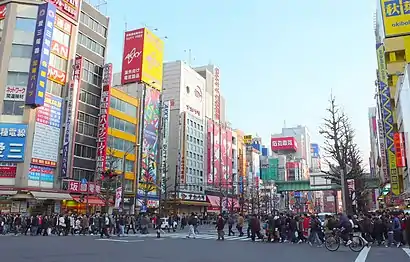
Akiba-kei (Japanese: 秋葉系) or Akiba-chan (アキバちゃん) is a Japanese slang term for Akihabara style. Akihabara is a district in Chiyoda, Tokyo where many otaku—or obsessive fans of anime, manga, idol, and video games—gather.
Definition
Akiba-kei is a Japanese slang term meaning "Akihabara style". It dates back to the early 80s and refers to a subculture of otaku that spend a significant amount of time in and around the Akihabara area of Tokyo and are known for their strong interest in "fantasy worlds...anime, manga, maids, idols, and games".[1] Akiba-kei have also been characterized as being "interested in ruminating about domestic items and creating fan works based on these existing elements."[2]
Location
The Akihabara area in central Tokyo is known as a marketplace of technology. It has ties to the Japanese video game industry, as well as to anime and manga publishers.[3]
Akiba-kei frequently open their own shops in Akihabara. Most of these shops are run by Akiba-kei in cosplay, who may claim that such attire is the rule for them rather than the exception.[4] The shops offer a wide variety of goods and services: some sell model or ornamental weaponry;[4] others are modeled after antique reading rooms; and still others sell quirky or innovative foodstuffs.
In popular culture
Within Japan's larger popular culture, Akiba-kei, for the most part, belong to an older generation well-versed in the history of Akihabara before it ever became a center of pop culture. Some of them, affectionately known as "Akiba historians", have worked in and around the Akihabara area for decades and witnessed firsthand the changes the area went through. In addition to running shops and participating in Akiba-kei culture, they may also be fonts of knowledge about Akihabara and its environs.[5]
In early 2008, a project was undertaken to attempt to merge some aspects of Akiba-kei culture with Shibuya-kei, Japan's "super-chic internationalist music, fashion, interior, and design movement" that began in Japan in the 1990s. In writing about this project, W. David Marx of Diamond Agency's culture blog observed:
Instead of fighting technological change, Akiba-kei otaku skillfully use the internet as a way to discuss and consecrate their favorite cultural items and disseminate new works to their community. This has only made the subculture stronger. In the end, the Akiba-kei subculture has won a top spot in the contemporary pop landscape because its culture has been least affected by the last decade's democratization of media and the decline in the culture markets.[2]
Akiba-kei Idol
Akiba-kei idols are Japanese idols representing Akihabara style. The activities of Akiba-kei idols were started by women influenced by the style of underground idols created by Aoi Mizuno.
In the 1990s, Akihabara was developing into a neighborhood centered on male otaku interests. However, there were a few women who liked Akihabara, including Haruko Momoi, "the Queen of Akihabara" and Mizuno. Mizuno, who made her debut before Haruko Momoi, started her activities as an underground idol by cosplaying as Shiori Fujisaki. Momoi is the first known Akiba-kei idol. Beginning her activities in 1996, Haruko Momoi is still very early in the life cycle of her activity.[6] The tarento Shoko Nakagawa is also an Akiba-kei idol in Japan, starting her activities in 2001. The female idol group AKB48, one of Japan's highest selling contemporary musical acts, runs its own theater in Akihabara, from which the group's name is derived.[7] Another female idol group Dempagumi.inc is composed entirely of performers claiming to be otaku of some genre. By the time of Dempagumi.inc, formed in 2009, the number of Akiba-kei idols had increased considerably.
With the spread of otaku culture, it is no longer necessary to distinguish this place by name, since Akiba-kei is becoming a dead language. Some artists who were called Akiba-kei idols in the past are performing works beyond the framework of Akiba-kei.
See also
References
- ↑ "Glossary". Archived from the original on 22 February 2009.
{{cite web}}: CS1 maint: unfit URL (link) - 1 2 "Neomarxisme". Archived from the original on 14 July 2011. Retrieved 30 November 2010.
- ↑ "Japan Guide". Archived from the original on 27 April 2011. Retrieved 12 February 2009.
- 1 2 "Bukiya weaponry shop". Archived from the original on 4 March 2016. Retrieved 21 March 2020.
- ↑ "Akiba historians article". Archived from the original on 4 March 2016. Retrieved 21 March 2020.
- ↑ "桃井はるこ(Rooftop2015年9月号) – インタビュー". Rooftop (in Japanese). Archived from the original on 24 October 2020. Retrieved 22 October 2020.
- ↑ "A Beginner's Guide to the 48Group Family". www.tsunagujapan.com. Retrieved 14 February 2019.
